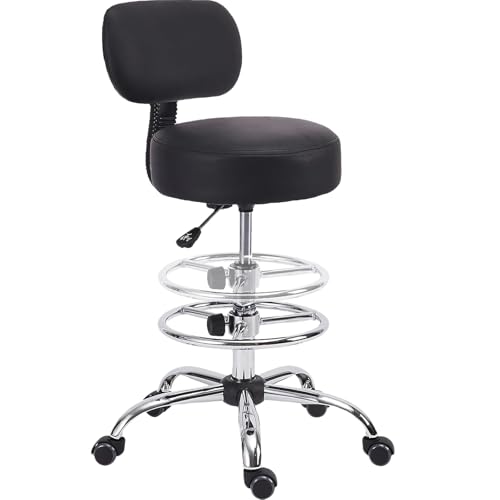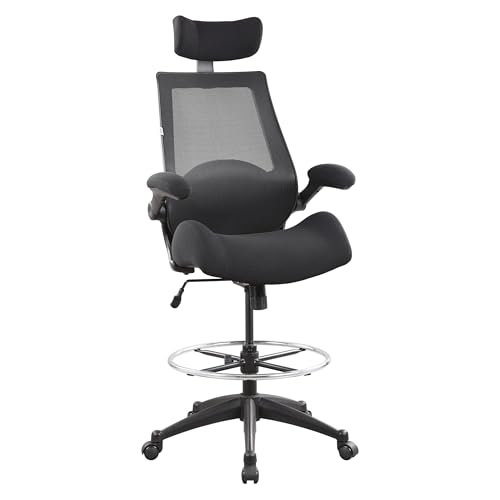As someone who spends hours alternating between a standing desk, a high drafting table, and a workbench, I know the struggle intimately. Standard office chairs leave you feeling like a child at the adult’s table, craning your neck and straining your shoulders. Perching on a simple stool offers height but quickly leads to back pain and fatigue. This is the precise problem that sends so many of us on a quest for a proper drafting chair: a hybrid solution that promises the height of a stool with the ergonomic support of an office chair. The goal is simple—to find a comfortable, stable, and adjustable seat that can keep up with a dynamic workspace. Neglecting this crucial piece of equipment isn’t just an inconvenience; it can lead to chronic pain, poor posture, and a significant drop in productivity. We decided it was time to put a popular and budget-friendly contender to the test, and our focus landed squarely on the KLASIKA Drafting Chair with Footrest.
- 【High-Quality PU Leather】KLASIKA drafting chair, clad in sleek black premium PU leather. Padded seat and back support offer comfy...
- 【Ergonomic Design】Ergonomically designed shop stool. Contoured backrest gives great back support, cuts strain during long sits....
What to Consider Before Buying a Drafting Chair
A drafting chair is more than just a tall office chair; it’s a key solution for maintaining proper posture and comfort when working at elevated surfaces like standing desks, architectural tables, lab counters, or reception desks. Its primary benefits are the extended height adjustment and the inclusion of a footrest ring, which provides a crucial perch for your feet to prevent them from dangling, thereby reducing pressure on the lower back and improving circulation. It bridges the gap between sitting and standing, offering a supportive “third option” for dynamic work environments.
The ideal customer for this type of product is someone facing the daily challenge of working at a counter or desk that is higher than the standard 30 inches. This includes artists, engineers, lab technicians, architects, cashiers, and home office workers who have embraced the standing desk trend. They need a chair that can rise to the occasion without sacrificing stability or basic ergonomic support. Conversely, this type of chair might not be suitable for those who work exclusively at a standard-height desk, as even at its lowest setting, a drafting chair can be too tall. Furthermore, users who require advanced ergonomic features like adjustable lumbar support, seat depth adjustment, or 4D armrests for continuous 8-hour sitting sessions may find most drafting stools too simplistic for their needs.
Before investing, consider these crucial points in detail:
- Dimensions & Space: Pay close attention to the seat height range. The KLASIKA model boasts a range of 24.9 to 32.2 inches, which is substantial. You must measure your desk or counter height and ensure the chair’s range allows your legs to be at a comfortable angle. Also, consider the base diameter (23.6 inches here) to ensure it fits within your workspace without becoming a tripping hazard.
- Capacity/Performance: Weight capacity is a non-negotiable safety feature. This chair supports up to 275 pounds, which accommodates most users, but it’s always wise to check. Performance also includes the smoothness of the gas lift, the 360-degree swivel, and the quality of the casters. You want a chair that moves easily when you want it to, and stays put when you don’t.
- Materials & Durability: The frame and base are the chair’s skeleton. A metal frame, like the one on the KLASIKA, is generally superior to all-plastic construction for longevity. Seat material is a matter of preference and use case; the PU leather on this model offers a sleek look and is easy to clean, but might not be as breathable as a mesh back alternative during long sessions.
- Ease of Use & Maintenance: Assembly should be straightforward, though as we discovered, this can be inconsistent. For maintenance, PU leather is low-effort, typically requiring just a wipe with a damp cloth. The most critical “ease of use” feature, however, is the adjustability of the components, particularly the footrest, which must be easy to set and reliably stay in place.
While the KLASIKA Drafting Chair with Footrest is a compelling option in its category, it’s always wise to see how it stacks up against the competition. For a broader look at all the top models, we highly recommend checking out our complete, in-depth guide:
- Adjustable Drafting Chair:This high rotary drawing chair has a foot stool with adjustable height, and the 90 degree overturned armrest...
- 【Comfortable Sponge Cushion】The larger and thicker seat of this drafting chair is made from upgraded foam with higher density,...
- Drafting Chair With Headrest: 3D designed headrest with height adjustable foot ring.The 90-degree flipped arms can save indoor space,...
Unboxing and First Impressions of the KLASIKA Drafting Chair with Footrest
The chair arrived in a surprisingly compact and lightweight box, tipping the scales at just 18 pounds. Upon opening, all components were neatly organized and individually wrapped to prevent scratching. The parts list is minimal: the seat with backrest pre-attached, the gas lift cylinder, the five-star base, the footrest ring, and a pack of casters and screws. The initial impression of the materials was decent for the price point. The black PU leather on the seat and backrest was smooth and seemed well-stitched, presenting a clean, modern aesthetic that you can view in more detail online.
Assembly, for us, was mostly a breeze, aligning with reports from several users who found it exceptionally easy. The casters snap into the base, the cylinder slots in, and the footrest slides over it. The final step is attaching the seat plate to the underside of the cushion with four screws. However, this is where we hit our first snag—a sign of the quality control issues that would become a central theme of this review. One of the four screw holes was slightly misaligned, requiring considerable force and careful maneuvering to get the bolt to catch its thread. This is a frustration echoed by other users, some of whom were unable to secure all four bolts. While we eventually succeeded, it’s a clear indicator of manufacturing inconsistency.
What We Like
- Generous seat height range suitable for very high counters
- Smooth-rolling casters provide easy mobility on hard surfaces
- Sleek and professional PU leather finish is easy to clean
- Straightforward assembly process (when parts align correctly)
What We Dislike
- Critically flawed footrest design that fails to hold weight
- Inconsistent manufacturing quality control (misaligned holes, rust)
A Detailed Analysis of the KLASIKA Drafting Chair in Action
Putting a chair through its paces means more than just sitting on it for a few minutes. We integrated the KLASIKA Drafting Chair with Footrest into our daily workflow for over a week, using it at a drafting table, a high workbench, and a standing desk. This extended testing period revealed a chair with some admirable qualities but also one with a significant, almost deal-breaking, flaw.
Adjustability and Height: Reaching New Levels (Sometimes Too High?)
The primary function of a drafting chair is to provide height, and in this regard, the KLASIKA delivers—and then some. The pneumatic gas lift operates smoothly, allowing for quick adjustments via a simple lever under the seat. The specified height range of 24.9 inches to 32.2 inches is not only accurate but places this chair among the taller options available in this price bracket. At its maximum height, it was more than capable of accommodating our 42-inch standing desk, allowing for a comfortable seated position that kept our arms at a proper ergonomic angle. This impressive range is one of its main selling points, and you can check the exact measurements and latest price here.
However, this strength can also be a weakness for some users. We noted that even at its lowest setting of nearly 25 inches, the chair remains quite tall. This was confirmed by user feedback, with one 5’3″ individual reporting that the chair was dangerously high for them. They mentioned needing a step stool just to get on the chair to activate the lever to lower it. This is a critical safety and usability concern. While ideal for taller individuals or very high surfaces, we would caution shorter users (under 5’5″) to carefully measure their ideal seating height before considering this model, as it may simply be too tall to use safely and comfortably.
The Achilles’ Heel: A Critical Look at the Footrest
If the height range is the chair’s headline feature, the footrest is its tragic flaw. A drafting chair’s footrest is not an optional accessory; it is an essential ergonomic component. It provides the support necessary to alleviate pressure on the thighs and lower back when sitting at height. The design used by KLASIKA is, unfortunately, wholly inadequate for this purpose. The system consists of a chrome ring that slides over the main gas cylinder, which is meant to be held in place by a single plastic collar that you tighten with a hand-screw.
From the moment we tried to secure it, we knew there would be trouble. The small plastic ring and single point of pressure felt flimsy. Our hands-on testing confirmed our fears immediately. Even with the knob tightened as much as possible, resting a single foot on the ring caused it to slip. Placing the weight of both feet on it, as one naturally would, made it slide down the polished cylinder shaft to the base with zero resistance. We tried re-tightening and repositioning, all to no avail. The design is fundamentally flawed. This isn’t just our finding; it is the single most common and vehement complaint from users. One reviewer perfectly captured the universal experience, stating, “It has a flimsy plastic ring… Plastic is not strong enough to even rest your one foot, let alone two. It slides down to very bottom.” Without a functional footrest, the user is left with dangling feet, which completely negates the ergonomic benefit of the chair and leads to discomfort and poor posture—a design choice that potential buyers should be aware of before they decide to purchase this chair.
Seating Comfort and Build Quality: A Mixed Bag
Setting aside the critical footrest issue, how does the rest of the chair hold up? The seat itself, with a diameter of 15.4 inches, is adequately sized for most users, though larger individuals might find it a bit snug. The product description boasts a “thick seat cushion,” and while it’s not uncomfortably thin, we found it to be merely average. The padding provides reasonable comfort for short-term sitting of an hour or two, but during longer work sessions, we could feel the base plate beneath, suggesting the foam may not hold up to extended, all-day use without compressing.
The build quality of the core components is surprisingly robust. The stainless steel five-star base feels solid and stable, even at maximum height, and the casters roll smoothly and quietly across our hard flooring. The chair is rated for 275 pounds, and based on the sturdiness of the base and metal frame, we feel this is an accurate assessment. The solid base provides a stable foundation, a feature that sets it apart from some flimsier models. However, this praise for the core structure is again undermined by inconsistent quality control in the finishing details. As mentioned, our unit had a misaligned screw hole. Other users have reported receiving components with rust, particularly on the footrest ring, straight out of the box. This lottery of quality control means that while you might receive a perfectly fine unit, you could just as easily receive one with frustrating and fundamental defects.
What Other Users Are Saying
After our own extensive testing, we delved into a wider pool of user feedback to see how our experience compared. The sentiment is starkly divided and seems to hinge on two factors: whether the user received a defect-free unit and whether they require a functional footrest. On the positive side, many users praise the chair’s height and easy assembly. One happy customer noted, “This chair was so easy to put together! It turned out great… It’s perfect! Oh, and it rolls easily too.” Another found it to be a perfect fit for their specific needs, stating, “I have a desk, print table and a small drafting table… This is perfect for drafting table. Comfortable.”
However, the negative feedback is consistent and focuses on the same critical flaws we identified. The non-functional footrest is the most frequent deal-breaker. The second major point of contention is quality control, with multiple reports of misaligned screw holes preventing assembly. “Second chair can’t be assembled (holes on base plate don’t line up with holes on seat, 4th bolt won’t go in),” one frustrated buyer wrote. A particularly concerning trend mentioned in feedback involves difficulty with returns, with one user claiming it would cost more to ship the defective product back than the chair itself was worth, effectively trapping them with a non-functional item.
How Does the KLASIKA Compare? Top Alternatives Explored
Given the significant drawbacks of the KLASIKA chair, it’s essential to consider other options on the market. Depending on your priorities—be it a similar aesthetic, better ergonomics, or more reliable quality—one of these alternatives might be a much better fit.
1. Brick Attic Drafting Chair with Backrest
The Brick Attic Drafting Chair appears to be a direct competitor, sharing a very similar design language with the KLASIKA. It features a backless or low-back stool design, PU leather upholstery, a chrome footrest ring, and a five-star base with casters. For a buyer who is drawn to the minimalist, workshop-style aesthetic of the KLASIKA but is wary of its documented quality control and footrest issues, the Brick Attic model presents a worthwhile alternative to investigate. It occupies the same niche for use in salons, studios, labs, or at a kitchen counter, and comparing recent user reviews for both could be the deciding factor in which one is less of a gamble.
2. HYLONE Tall Drafting Chair with Footrest
If your primary need is ergonomic support for longer periods of work at a standing desk, the HYLONE drafting chair is a significant step up. It moves away from the simple stool design and offers features more akin to a traditional office chair. With a high, breathable mesh back, it provides much better lumbar and thoracic support. The inclusion of flip-up arms adds versatility, allowing you to move them out of the way for tasks that require more freedom of movement. This chair is built for productivity and comfort over pure aesthetics, making it a superior choice for anyone who plans to sit for more than a couple of hours at a time.
3. Primy Tall Drafting Chair with Flip-up Armrests
The Primy Drafting Chair is another excellent alternative for those who prioritize comfort and features. Similar to the HYLONE, it boasts an executive ergonomic design with a high back, built-in lumbar support, and flip-up armrests. It aims to provide a full-featured office chair experience at an elevated height. This model would be ideal for a user in a professional setting or a dedicated home office who uses a standing desk as their primary workspace. The focus on lumbar support and adjustability makes it a far better choice for protecting your posture and ensuring long-term comfort compared to the very basic support offered by the KLASIKA.
Final Verdict: Who Should Buy the KLASIKA Drafting Chair with Footrest?
The KLASIKA Drafting Chair with Footrest is a product of contradictions. It offers an excellent height range, a sleek appearance, and a price tag that is undeniably attractive. In a perfect world, it would be an easy recommendation for workshops, art studios, or casual use at a kitchen counter. However, we do not live in a perfect world, and this chair’s flaws are too significant to ignore. The footrest is, in our expert opinion, completely non-functional, which is a critical failure for a drafting chair. When combined with the lottery of inconsistent quality control that can leave you with misaligned parts or a rusty finish, the initial value proposition begins to crumble.
We can only recommend this chair under a very specific and limited set of circumstances: if you are a lighter individual, do not need or care about using a footrest, require its specific height range, and are willing to take a chance on the manufacturing quality. For everyone else, especially those seeking genuine ergonomic support to get through a workday, we strongly advise you to look elsewhere. The alternatives we’ve listed offer far more reliable functionality and comfort. While the idea of the KLASIKA is good, the execution is simply too flawed to earn our unconditional recommendation. If you’ve weighed the pros and cons and feel its unique strengths align with your limited needs, you can find the KLASIKA Drafting Chair with Footrest available here.
Last update on 2025-11-20 / Affiliate links / Images from Amazon Product Advertising API




